I have a question about the button count on a peacoat. How many buttons is a peacoat supposed to have in total? For example, a modern melton wool peacoat would have eight on the outside (six showing and two beneath the collar flaps) and one on the inside, correct?
Want to buy or sell something? Check the classifieds
-
The Fedora Lounge is supported in part by commission earning affiliate links sitewide. Please support us by using them. You may learn more here.
You are using an out of date browser. It may not display this or other websites correctly.
You should upgrade or use an alternative browser.
You should upgrade or use an alternative browser.
Questions About the United States Navy Peacoat
- Thread starter Matt Jones
- Start date
EmergencyIan
Practically Family
- Messages
- 918
- Location
- New York, NY
I have a question about the button count on a peacoat. How many buttons is a peacoat supposed to have in total? For example, a modern melton wool peacoat would have eight on the outside (six showing and two beneath the collar flaps) and one on the inside, correct?
Eight (six showing) since just after WWII.
- Ian
Eight (six showing) since just after WWII.
- Ian
One of the top buttons is used to hold the flap when flipping the collar up and folding it over. Is the other top button decorative?
EmergencyIan
Practically Family
- Messages
- 918
- Location
- New York, NY
One of the top buttons is used to hold the flap when flipping the collar up and folding it over. Is the other top button decorative?
Yes, to button down the “flap.”
They have rows of buttons on the left and right because they can be button either way.
- Ian
Interesting. So, if you are buttoning the coat in the opposite direction, you only use two buttons, right? One at the top and the in the middle. Does that mean the button on the inside of the coat, above the small pocket, is simply an extra button? All this time I thought it was intended to secure one side before buttoning up the other side.
- Messages
- 6,309
- Location
- South of Nashville
You can use it for that purpose if you wish. I found it was more trouble than it was worth.Interesting. So, if you are buttoning the coat in the opposite direction, you only use two buttons, right? One at the top and the in the middle. Does that mean the button on the inside of the coat, above the small pocket, is simply an extra button? All this time I thought it was intended to secure one side before buttoning up the other side.
1965 was the last year that allowed the coat to be buttoned from either the left or the right.
Regulations require all six of the buttons on the front be fastened. Regulations for the WWII coats required that all eight of the buttons be fastened. Sailors didn't like that buttoned up to the throat look, so they routinely left the top button unfastened, in violation of the clothing regulations. This gave the lapel an unruly look as it didn't lie flat against the chest. I believe this is the reason the Navy changed to the six button (showing) style that allowed all buttons to be comfortably fastened, a tamed lapel that lay flat, while having only a slightly larger opening at the throat.
The post war peacoat was designed so that the wearer could button up to the throat if desired. I believe there is a picture of this configuration in my guide.
EmergencyIan
Practically Family
- Messages
- 918
- Location
- New York, NY
You can use it for that purpose if you wish. I found it was more trouble than it was worth.
1965 was the last year that allowed the coat to be buttoned from either the left or the right.
Regulations require all six of the buttons on the front be fastened. Regulations for the WWII coats required that all eight of the buttons be fastened. Sailors didn't like that buttoned up to the throat look, so they routinely left the top button unfastened, in violation of the clothing regulations. This gave the lapel an unruly look as it didn't lie flat against the chest. I believe this is the reason the Navy changed to the six button (showing) style that allowed all buttons to be comfortably fastened, a tamed lapel that lay flat, while having only a slightly larger opening at the throat.
The post war peacoat was designed so that the wearer could button up to the throat if desired. I believe there is a picture of this configuration in my guide.
That explains why I was confused by Zen’s post. I don’t have a coat post 1965. So, my pea coats can be buttoned on either side. However, probably like most men, I only button mine with the buttons on the right hand side.
- Ian
responsible D
New in Town
- Messages
- 13
I have a question for Peacoat and the other experts here. Has anyone seen a vintage peacoat with buttons that they know, beyond any doubt, are in their original state? I'm going to reattach some buttons on one of my coats (a nice one that appears to be from 1952) and I'd to do it in the authentic fashion, but I'm not sure about a couple of basic things:
1. Are the buttons sewn through the liner? Meaning that the back side of the button thread is not hidden behind the liner, but rather you can see the back side of the button thread inside the coat, or inside the pocket.
2. What is the pattern of the thread on the front side of the button?
1. Are the buttons sewn through the liner? Meaning that the back side of the button thread is not hidden behind the liner, but rather you can see the back side of the button thread inside the coat, or inside the pocket.
2. What is the pattern of the thread on the front side of the button?
Last edited:
- Messages
- 6,309
- Location
- South of Nashville
The buttons originally were not sewn through the lining, but it is perfectly OK for you to have it done that way; just don't sew through the pockets so they are unusable.
I have seen all different patterns for attaching the buttons. Ensure the top of the anchor is facing up. I have seen thread only in the top and bottom holes. I have seen it in all four holes with a two by two thread pattern, and I have seen it in a zig zag pattern. Just follow whatever pattern is on your other buttons.
I have seen all different patterns for attaching the buttons. Ensure the top of the anchor is facing up. I have seen thread only in the top and bottom holes. I have seen it in all four holes with a two by two thread pattern, and I have seen it in a zig zag pattern. Just follow whatever pattern is on your other buttons.
responsible D
New in Town
- Messages
- 13
The buttons originally were not sewn through the lining, but it is perfectly OK for you to have it done that way; just don't sew through the pockets so they are unusable.
I have seen all different patterns for attaching the buttons. Ensure the top of the anchor is facing up. I have seen thread only in the top and bottom holes. I have seen it in all four holes with a two by two thread pattern, and I have seen it in a zig zag pattern. Just follow whatever pattern is on your other buttons.
Thanks, I appreciate the feedback. My guess was that they weren't sewed through the lining, but every button on my coat was sewn that way. I guess they had all been replaced at one time or another, not surprising for something more than 60 years old.
I decided to re-sew all of the buttons since they were all in various states of disrepair, a couple having come off and others barely hanging on.
I went with stitching that runs diagonally in two places, between 6 o'clock and 3, and between 12 and 9. That keeps all the thread recessed in the two slots that run between those locations.
The original thread used to assemble the garment appears to be a natural material (or at least it burns like it is), I assume cotton, and fairly heavy duty with multiple visible strands. I wasn't able to find heavy duty cotton thread, so I went with the closest I could find - a black "button and carpet" thread made by Singer that's available on Amazon, 30% cotton and 70% polyester. It should be tough enough to last for a while and it looks fine.
It's pretty simple to sew a button but if anyone wanted to see the method I developed I could post a few photos.
I'd like to be able to repair some of the button holes too, where the thread that forms the edges of the hole is fraying, but that's more intricate work and I don't have a good idea for how to tackle it properly so for now they stay as-is.
responsible D
New in Town
- Messages
- 13
I came across a peacoat that was manufactured in 1973 of melton wool. That would suggest that if all contractors were held to the same specifications then all peacoats manufactured in 1973 would have been made with melton wool regardless of whether it was labeled as such.
I have one of those. I've wondered if it was a prototype for testing the Melton fabric, which would have been new at the time and didn't replace Kersey until a number of years later (1979?).
responsible D
New in Town
- Messages
- 13
"a tailor let out the sleeve hems and I gained about a inch in length"
I have done that with a couple of 1940s and 1950s peacoats, for the same reason. They all look great. Because of the dark color you barely see anything (unless you are 5 inches from the seem)
I did this recently with a 1950s coat. The nap was worn off the original cuff ends, and after letting out all of the extra fabric at the sleeve end, there is a ring of wear encircling the cuff, about half an inch from the new end, but like you say it's only noticeable if you know what to look for and get up close.
I don't know of a way to restore the nap, but I tried to blend it in by misting the area with some water and going to town on it with a garment brush. It helps.
I let the cuff out myself - there's just one seam there and it's pretty easy to rip it out, and at that point you can just unroll the sleeve toward its end. I decided not to put another stitch in, because it stays in place just fine after a little bit of pressing with an iron. So if you're not a stickler for that detail, then sleeve extension is a very easy DIY project.
- Messages
- 6,309
- Location
- South of Nashville
You are close, but Kersey was no longer used after 1979.I have one of those. I've wondered if it was a prototype for testing the Melton fabric, which would have been new at the time and didn't replace Kersey until a number of years later (1979?).
Tec
New in Town
- Messages
- 24
- Location
- United States
I'm such an impulsive person. I don't even quite remember what led me here, but I remember looking at one of my olive peacoats in the closet and ended up reading a bunch of posts. Went over to eBay and bought a 1961 peacoat. My excuse was that I didn't have a "black" coat, so why not.
Should be here by Saturday, so I'll take my own pictures then. Here are some from the listing:
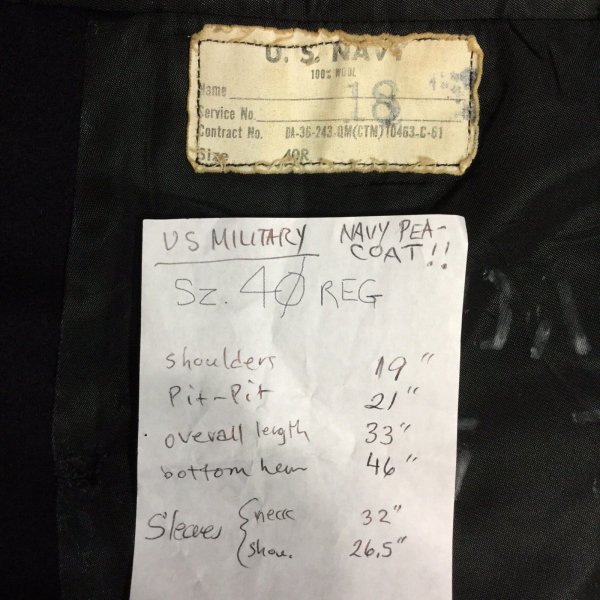
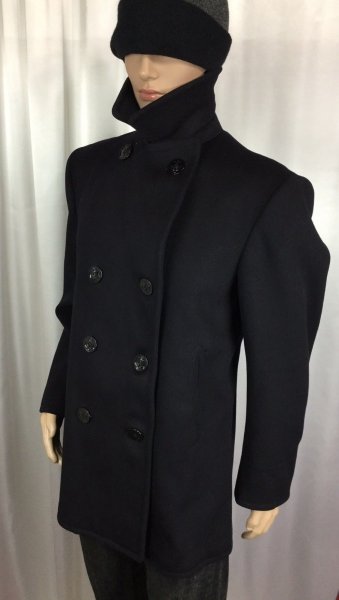
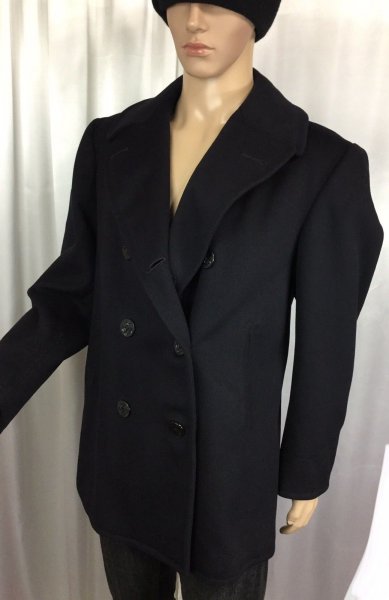
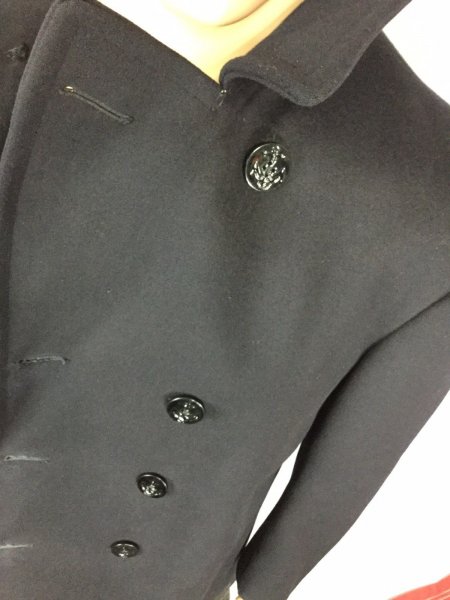
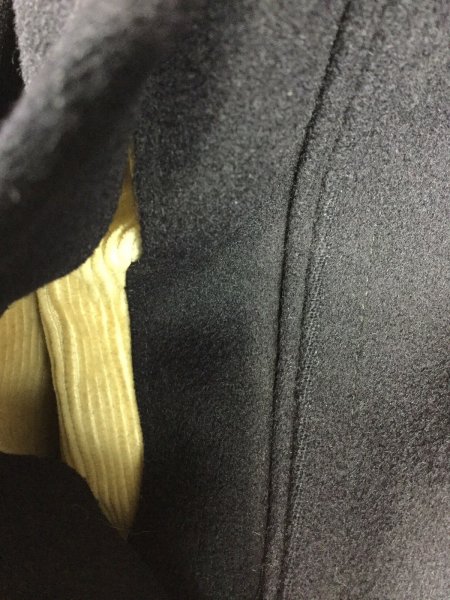
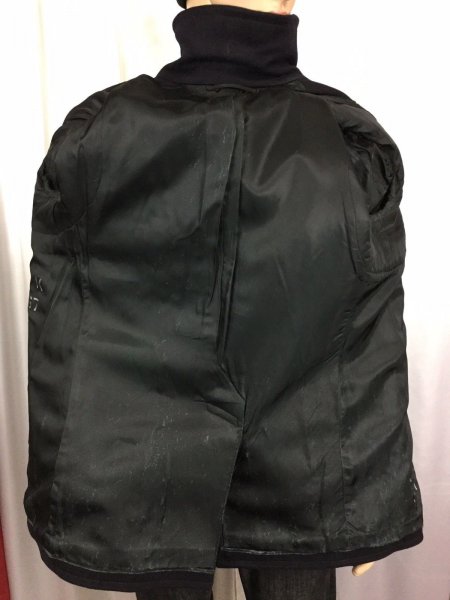
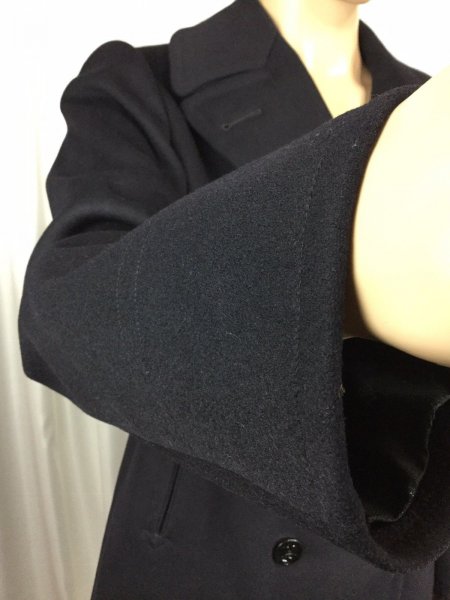
I feel like I see the most subtle hint of blue in there. It could just be the pictures/my monitor and eyes though. The listing itself said it's black. Although according to @Peacoat's dating guide, it is midnight blue, right? I literally just started looking up this stuff this afternoon so I don't know much about this. Either way I'm happy.
Should be here by Saturday, so I'll take my own pictures then. Here are some from the listing:







I feel like I see the most subtle hint of blue in there. It could just be the pictures/my monitor and eyes though. The listing itself said it's black. Although according to @Peacoat's dating guide, it is midnight blue, right? I literally just started looking up this stuff this afternoon so I don't know much about this. Either way I'm happy.
AbbaDatDeHat
I'll Lock Up
- Messages
- 8,645
Welcome to the lounge Tec.
Nice impulsive buy. Looks in fine condition.
Bowen
Nice impulsive buy. Looks in fine condition.
Bowen
- Messages
- 6,309
- Location
- South of Nashville
For that 1961 pea coat, it will be midnight blue and not black. The black (to my eyes, anyway) started in 1980. Congratulations.
And yes, welcome to the lounge.
And yes, welcome to the lounge.
I know you have seen probably hundreds of peacoats. Have you encountered any peacoats dated after 1972 that were labeled Kersey wool? The ones I have seen from 1973 onwards are labeled Melton wool or simply 100% wool.You are close, but Kersey was no longer used after 1979.
- Messages
- 6,309
- Location
- South of Nashville
Actually, I have seen probably thousands of peacoat tags and peacoats. From what I have learned is that coats from those years were Kersey unless labeled as Melton. I have never seen a pre 1980 coat made of Melton unless it was so noted on the label.I know you have seen probably hundreds of peacoats. Have you encountered any peacoats dated after 1972 that were labeled Kersey wool? The ones I have seen from 1973 onwards are labeled Melton wool or simply 100% wool.
I can't get to my walk in closet, where most of my peacoats live without awakening my wife. So I will leave that for tomorrow (if I can remember to do it). I think I have at least one coat from 1973 through 1979 in the closet. Maybe a 1978 coat?
- Messages
- 6,309
- Location
- South of Nashville
I checked my coats this morning. Other than two post 1979 coats (melton) the latest year I have is 1972. It is labeled as "100% wool, Kersey." So, I can't answer your question about '73 and beyond.
patrick_b
One of the Regulars
- Messages
- 239
- Location
- Boston, MA
Thanks, I appreciate the feedback. My guess was that they weren't sewed through the lining, but every button on my coat was sewn that way. I guess they had all been replaced at one time or another, not surprising for something more than 60 years old.
I decided to re-sew all of the buttons since they were all in various states of disrepair, a couple having come off and others barely hanging on.
I went with stitching that runs diagonally in two places, between 6 o'clock and 3, and between 12 and 9. That keeps all the thread recessed in the two slots that run between those locations.
The original thread used to assemble the garment appears to be a natural material (or at least it burns like it is), I assume cotton, and fairly heavy duty with multiple visible strands. I wasn't able to find heavy duty cotton thread, so I went with the closest I could find - a black "button and carpet" thread made by Singer that's available on Amazon, 30% cotton and 70% polyester. It should be tough enough to last for a while and it looks fine.
It's pretty simple to sew a button but if anyone wanted to see the method I developed I could post a few photos.
I'd like to be able to repair some of the button holes too, where the thread that forms the edges of the hole is fraying, but that's more intricate work and I don't have a good idea for how to tackle it properly so for now they stay as-is.
I'm curious to see your images. I've sewn countless buttons but never on my Peacoat (5 y/o Sterlingwear Authentic) because they don't sew through the lining. I love the jacket but every year the two most used buttons unravel. I drive by the Sterlingwear factory/retail store often on the way to the airport so every year, I have them fix it. Within a month or so, they start to unravel again. There has to be a way to sew them so they stand up to regular use.
Similar threads
- Replies
- 0
- Views
- 7K
- Replies
- 9
- Views
- 3K
- Replies
- 3
- Views
- 2K
Members online
- Mister Rivets
- ojaw
- BigPond
- PanosChris
- BDL
- giangiobomber
- Dlaniger
- TelemarkTumalo
- Wandering Nomad
- frogbart123
- Aloysius
- joezam713
- Rmccamey
- Aladeen's magic carpet
- LA23beswak
- RickP
- firsttimebuyer
- jej
- J. Randall
- steve740
- P2D
- tpschar
- scottbbishop
- Haitham
- voodootomato
- cdallas
- jeo
- moehawk
- Mormus
- 4T2
- Thedenimdentist
- unhatted
- Crotalus500
- Backchannel
- Jeff B.
- X83
- Altiori
- dice140
- Pressgo
- G MAN
- Kubatu
- thor
- Jiantle
- Tim S
Total: 4,175 (members: 62, guests: 4,113)